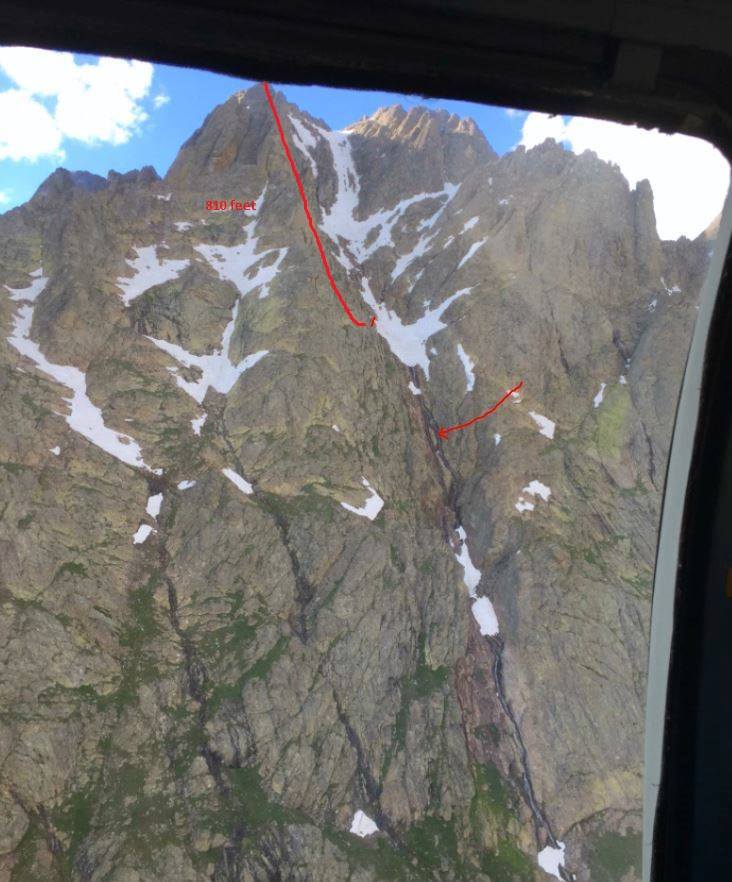Falls on Snow and Rock
Colorado, Sangre de Cristo Range, Crestone Peak

Several accidents, including one fatality, occurred in the Red Gully on the standard route up 14,294-foot Crestone Peak. Although it faces south, this rocky gully often holds snow well into July, presenting mountaineering challenges on what is otherwise a 3rd-class scramble.
On Saturday, July 11, Jennifer Staufer (39) and her climbing partner, Adam Vonnahme (38), climbed Crestone via the south face (class III). Both climbers had multiple 14er summits; Crestone was Jennifer’s 41st 14er. While ascending, they wore Micro Spikes and used ice axes, due to ice and snow on the route. During the descent, the snow appeared to be soft enough to forgo the Micro spikes. Near 13,000 feet, Jennifer slipped on an icy patch while crossing a couloir. Unable to self-arrest, she fell approximately 150 feet, stopping in a snowmelt waterfall. She had to wait for her climbing partner to help her move or she might have fallen farther.
Adam used both his cell phone and SPOT device to request help, texting important patient information, including that his partner was 10 weeks pregnant, likely had multiple fractures (including rib fractures and a broken leg), was cold and wet, and was having difficulty breathing. Saguache County SAR (SAGSAR), Custer County SAR (CCSAR), and Western Mountain Rescue Team (WMRT) of Gunnison County responded to the incident.
A Blackhawk helicopter from the High Altitude Army Aviation Site (HAATS) was in the area on another SAR mission on Blanca Peak. After completing that mission and refueling, seven CCSAR climbers were transported to the Cottonwood drainage at approximately 6 p.m. The helicopter then transported five members of WMRT to the scene, and EagleMed Salida inserted two SAGSAR personnel, for a total of 14 field personnel. Conditions in the couloir included wet rock, running water, snow, and ice.
The patient was stabilized and then lowered in a Stokes litter, in difficult terrain and in darkness, to a landing zone in the Cottonwood Basin, from which she was airlifted to Crestone at 1 a.m. She was transferred to the hospital for treatment of several serious injuries, including a closed pneumothorax (collapsed lung).
On Sunday afternoon, at 2 p.m., CCSAR was again activated, this time to assist Anika Jimenez (23), who also fell in the Red Gully on Crestone Peak and had an ankle injury. With a splinted ankle, she was able to hike out to the South Colony Lakes Trail, below Broken Hand Pass, where CCSAR members transferred her out of the basin via a Stokes litter. Earlier that morning, CCSAR members had encountered Jimenez’s party during the descent from the Staufer incident. They told the party of the earlier incident and warned them of conditions in the couloir.
On July 24, less than two weeks later, Christopher Kiryluk (34) died from a fall in the Red Gully. Similar to the incidents on July 11 and 12, the climber was not wearing crampons or Micro Spikes, and he slipped and fell on the descent.
On August 14, Bruce Owen (age unknown) suffered a broken ankle from a slip and fall in the same descent route. Two CCSAR members responded, assisted the subject to a landing zone, and bivied until dawn, when Flight For Life could land to transport the patient to an area hospital.
ANALYSIS
These accidents highlight the importance of being adequately equipped for a variety of conditions—and utilizing the equipment you carry—on the more difficult 14er climbs. Standard route descriptions may not warn climbers of early season snowpack, melting snow, and the associated increase in danger from falling ice and rock. These conditions often make climbs in the Crestones technical. Peakbaggers need to ascertain the conditions and turn back when they exceed their equipment or ability. (Source: Cindy Howard, Custer County Search and Rescue Captain.)


